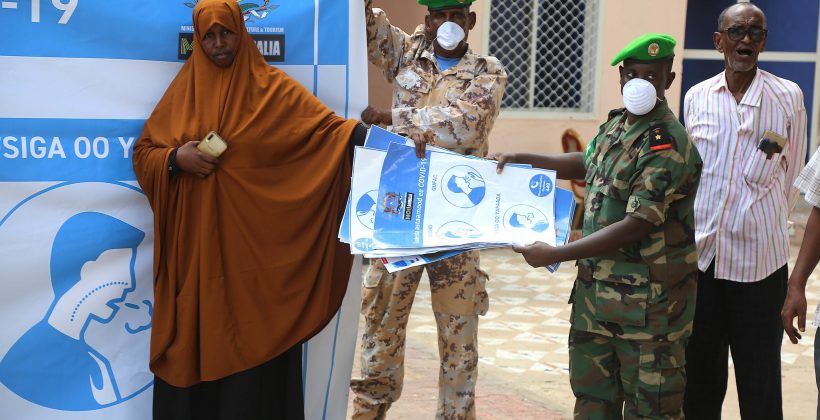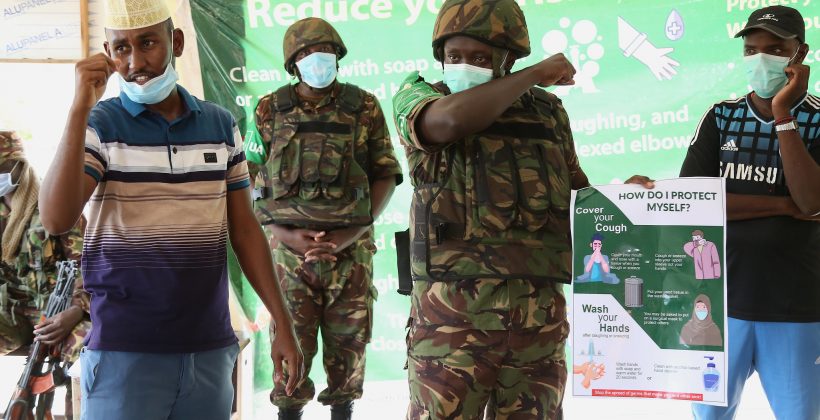Take Somalia. A country crippled by 30 years of conflict, where the UN estimates that 3.1 million people require health support and 2.6 million people are homeless because of instability. The Ministry of Health reports that it does not have access to a single ventilator and has only four intensive care unit beds. Doctors and hospital facilities are largely focused in the capital, Mogadishu, and extremist group al-Shabaab controls vast swathes of the country, making access to these areas near impossible. In South Sudan, conflict and violence have triggered the third largest refugee crisis on the planet. Almost 65% of the population relies on humanitarian assistance, and the IRC reports ‘a toxic mix’ of restricted movement, pre-existing high levels of malnutrition and chronic food insecurity.

For countries like these, COVID-19 presents not only an immediate health crisis but risks an even more significant longer-term crisis by exacerbating existing drivers of conflict.
1. Intensifying patterns of violence against vulnerable groups
COVID-19 related deaths, limited access to healthcare and economic shocks are all likely to disproportionately affect those from vulnerable and minority groups, intersecting with ethnic, religious and gender identities. Emerging evidence suggests women and girls, who are already at risk of domestic violence and sexual exploitation in conflict-affected settings, are experiencing a rise in abuse during the pandemic, particularly in humanitarian settings. Evidence from the Ebola crises in DRC, Liberia and Sierra Leone suggests that fear of violence, mistreatment and sexual exploitation prevent women and girls from accessing healthcare facilities during an epidemic.
2. Weakening of existing political settlements
In many fragile and conflict-affected settings, citizen-state relations are often already poor. Experience from the Ebola crisis in post-conflict West Africa shows the virus was initially allowed to spread at least in part because people simply didn’t trust the messaging coming from the government. In Somalia, the limited capacity of the government to respond effectively to this crisis, especially in areas outside of its control, may serve to bolster the influence of extremist groups like al-Shabaab. There are already signs that al-Shabaab is taking hold of the narrative and using it to undermine the state. But there are also significant risks posed by a heavy-handed approach. State responses, which have seen the increased policing of public spaces in countries where there is already deep-seated fear and mistrust in the police and armed forces, have resulted in violence.
3. Changing the calculations of conflict actors
A startling picture published in April of three heavily armed men on the front line in Tripoli wearing protective face masks against COVID-19 served to highlight that even in such extreme circumstances, conflicts continue. And yet, the pandemic is limiting the ability of the international community to support peacekeeping efforts, with many missions drawing down troops and pausing training. All this while already under-resourced national security forces are being redeployed to COVID-19 response. Some extremist groups have seen this as an opportunity to scale up violence. In a recent communique, al-Shabaab stated that efforts for jihad in East Africa should be intensified, while an IS newsletter urged supporters to launch attacks during the pandemic.
4. Restricting local and international capacities for peacebuilding
Some internationally led and funded conflict prevention and peacebuilding programmes have been put on hold as international staff are drawn down and the movement of local staff becomes ever more restricted. In countries such as South Sudan, where government capacity is extremely limited, support to local civil society organisations has played a crucial role in delivering conflict prevention and peacebuilding work. But much of this relies on building trust through face-to-face dialogue, and bringing people together has become increasingly difficult. The pandemic has forced the cancellation of crucial international summits in East Africa and the Sahel aimed to defuse regional tensions and boost counter-terrorism efforts.

How programmes can respond
So what does all this mean for those already implementing programmes designed to address conflict and instability? There are no easy fixes. We’re working with several clients to support them pivot existing programmes to respond to the crisis, and think there are three key ways to respond now:
- Understanding risk: An understanding of the new and emerging conflict risks should be central to any programme redesign or adaptation. It’s clear that COVID-19 is changing conflict dynamics and programmes need to be sensitive to what this looks like in their context to ensure any pivots don’t inadvertently cause harm.
- Real-time monitoring and analysis: For those of us working in the most challenging conflict settings, we have the advantage of a wealth of experience collecting data in non-permissive environments. Using existing remote third party monitoring activities to collect additional data on local impacts of COVID-19 can be a helpful way to gather real-time information on the situation, and start to identify localised trends. Focusing in on a small number of key indicators that are the most important can keep the scope realistic. It is, however, always important to consider who might be excluded by any data collection using technology, and what that means for the data programmes do get.
- Keeping one eye on the long term: Ongoing assessment of the impacts of COVID-19 will be essential to identify responses that can mitigate the longer-term consequences on conflict dynamics. Developing and tracking a basket of conflict and instability indicators can help here, with data pooled from a number of sources including local news reporting, social media and local partners. These can help identify where there are risks to stability or social unrest as a result of COVID-19 and if and how the emphasis of particular indicators changes over time as contexts shift. Despite the bleak picture, continuing to generate this type of analysis can help identify vital opportunities to reinforce peace.
By continuing to adapt and pilot these approaches with our clients, we are hoping to learn more about what works and we’ll keep sharing those insights.

